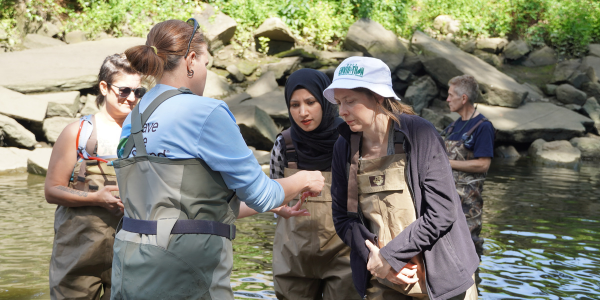
Save the Sound is developing a watershed plan for the Hutchinson River that aims to address community-identified issues. One of the biggest issues, identified by both the community and the state of New York, is pollution. Due to pollution, all segments of the lower Hutchinson River are listed on the New York State 303(d) list of impaired waterbodies.
But fighting this pollution problem requires understanding just how dirty the Hutch is.
“Last week, we took ten invested community members into the river,” says Watersheds Project Manager, Nicole Davis. “Walking through the water in waders, we took note of the trash and debris we found along the way. We found at least eight shopping carts, a wheelchair, and a bicycle in just a small portion of the river, objects you wouldn’t know were there unless you got into the river and saw it from the water’s perspective.”

Other than trash, the stream walkers found signs of riverbank erosion, a result of channelization, the straightening and deepening of channels in rivers.
“One simple measure the state can adopt to prevent further erosion is to install and protect riparian buffers along the riverbank by not mowing to the edge of the stream,” says Davis. “Vegetation at the riverbank stabilizes the sediment, preventing it from falling into the water and being transported elsewhere.”
While getting in the water showed the group what problems were alive in the river, the stream walk also showed them how resilient nature is.
“We found signs of wildlife everywhere despite the river’s poor condition,” says New York Ecological Restoration Project Manager, Megan Lung. “We found two live blue crabs, one molt of a blue crab (the old shell of a crustacean when it has grown larger), and schools of small fish. We even saw a lone Canada goose surveying the river from a shopping cart buried in the sediment. The juxtaposition of life and pollution in one environment was powerful. I felt an even greater drive to want to improve this river after having walked through it.”

The main goals of the watershed plan include identifying and proposing management for non-point source pollution, flood risk, and habitat restoration projects throughout the entire watershed in Westchester County.
The first phase of the plan is wrapping up, but there is still time to contribute your feedback during a second public stream walk in September, the upcoming steering committee meeting on September 13th, and a public meeting presenting the first draft of the plan in November. If you are interested in attending any of these events, please reach out to Nicole Davis and the Hutch team at reducerunoff@savethesound.org.
“We are excited to be at this phase in the development of the plan, bringing people face to face with the problems we are trying to solve,” says Davis. “This past stream walk sparked conversations about litter, accountability, flooding, restoration opportunities, and partnerships that can help remediate those issues. We will be out in the river a few more times this fall and invite anyone who is interested in providing feedback to join us. Once you experience the problem, it’s hard to unsee it, and these events and the conversations we have during them lead to real action.”

The Hutchinson River Watershed plan is a project split into two phases. Phase one focuses on the part of the watershed in Westchester County and phase two will focus on the portion in the Bronx. Phase one is being done in partnership with Westchester County Soil & Water Conservation District housed within the Westchester County Planning Department and is funded in part by NFWF and the Owens & Minor Foundation. Phase two will begin next year and is funded the state of New York facilitated by Assembly Member Michael Benedetto (AD-82).
